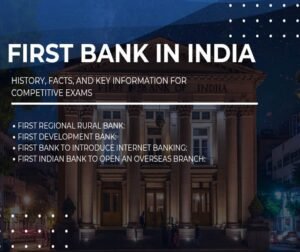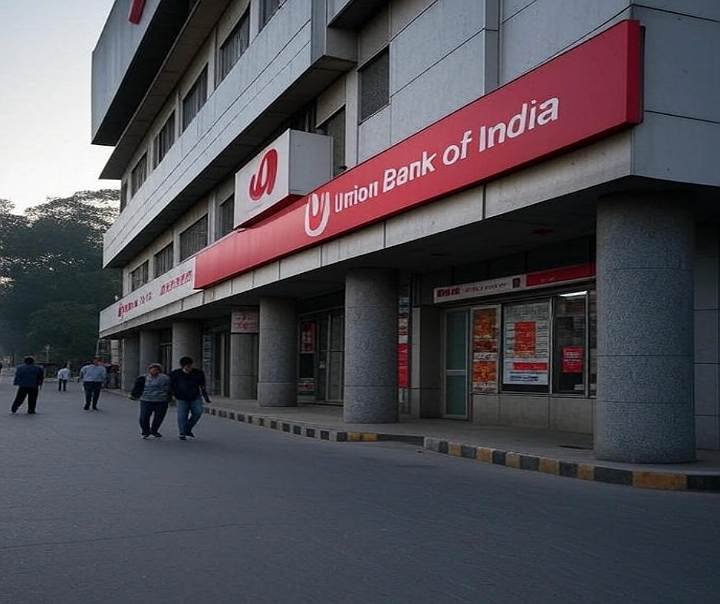The First Bank in India: History, Facts, and Key Information for Competitive Exams
The history of banking in India is both fascinating and extensive, making it a crucial topic for competitive exams like SSC, UPSC, Banking, Railway, or State PSC. In this post, we’ll dive deep into the details of first bank in india, its historical significance, and include some essential General Knowledge (GK) questions and answers that frequently appear in exams. I’ve also added natural backlinks to reliable sources for further reading.
A Brief History of Banking First Bank in India
Banking in India dates back to ancient times when moneylenders and merchants facilitated trade and loans. However, modern banking began during the British era. The Bank of Hindustan, established in 1770 in Calcutta, is considered India’s first bank. Founded by Alexander and Company, it operated until 1832 when it shut down due to financial difficulties.

Following this, the East India Company set up three Presidency Banks:
- Bank of Bengal (1806, chartered in 1809)
- Bank of Bombay (1840)
- Bank of Madras (1843)
These three banks were merged in 1921 to form the Imperial Bank of India, which later became the State Bank of India (SBI) in 1955. SBI remains India’s largest public-sector bank today, with a rich legacy. For more on SBI’s history, you can check out the State Bank of India’s official website.
India’s First Indigenous Bank
When it comes to fully Indian-owned and managed banks, the Punjab National Bank (PNB) holds the distinction of being the first, established in 1894 in Lahore (now in Pakistan). Founded by prominent figures like Lala Lajpat Rai, a freedom fighter, PNB was a symbol of Indian enterprise. It continues to be a leading bank in India. You can explore more about PNB on their official website.
Another significant mention is the Central Bank of India, established in 1911, often called the first truly indigenous bank due to its entirely Indian board and management. Its founder was Sorabji Pochkhanawala, with Pherozeshah Mehta as the first chairman.
Key Facts About Indian Banking
Here are some important facts often asked in competitive exams:
- First Regional Rural Bank: Prathama Bank, established in 1975, sponsored by Syndicate Bank.
- First Development Bank: Industrial Finance Corporation of India (IFCI), set up in 1948.
- First Bank to Introduce Internet Banking: ICICI Bank.
- First Indian Bank to Open an Overseas Branch: Bank of India, in 1946 in London.
For a deeper understanding of Indian banking history, you can refer to resources like the PDFs available on Byju’s website.
First Bank in India Related GK Questions and Answers for Competitive Exams
Below are some frequently asked GK questions related to banking in India, perfect for exam preparation:
Q1. Which was the first bank established in India?
Answer: Bank of Hindustan (1770–1832).
Q2. Which was India’s first indigenous bank?
Answer: Punjab National Bank (PNB), established in 1894.
Q3. Which was the first regional rural bank in India?
Answer: Prathama Bank, established in 1975.
Q4. When was the State Bank of India (SBI) established?
Answer: In 1955, following the nationalization of the Imperial Bank of India, though its roots trace back to the Bank of Calcutta in 1806.
Q5. Which Indian bank was the first to introduce internet banking?
Answer: ICICI Bank.
Q6. Which was the first development bank in India?
Answer: Industrial Finance Corporation of India (IFCI), established in 1948.
Q7. Which Indian bank opened its first overseas branch?
Answer: Bank of India, in 1946 in London.
Q8. Who was the first chairman of the Central Bank of India?
Answer: Pherozeshah Mehta.
Memorize these questions, as they frequently appear in exams like Banking, SSC, and UPSC. For additional GK resources, you can visit Jagran Josh, which offers a wealth of study material.
Phases of Banking Development in India
The evolution of banking in India can be divided into three key phases:
- Early Phase (1770–1969): This period saw the establishment of the Bank of Hindustan, Presidency Banks, and other early banks, many of which closed due to economic instability.
- Nationalization Phase (1969–1991): In 1969, 14 major banks were nationalized, followed by 6 more in 1980. This expanded banking services to rural and semi-urban areas.
- Liberalization Phase (1991–Present): Post-1991, the Narasimham Committee’s recommendations led to private banks receiving licenses, fostering competition in the sector.
To explore these phases further, platforms like Testbook offer detailed notes and mock tests.
Tips for Competitive Exam Preparation
- Make Notes: Jot down key dates, names, and facts about banking history for quick revision.
- Practice Mock Tests: Regularly take mock tests to assess your preparation. Websites like Examsbook provide free mock tests.
- Stay Updated with Current Affairs: Keep track of banking-related news, mergers, and policies.
- Use Reliable Sources: Study from trusted resources like NCERT books, the RBI website, or verified platforms.
While the Bank of Hindustan, India’s first bank, no longer exists, it laid the foundation for modern banking in the country. Indigenous banks like Punjab National Bank and Central Bank of India marked significant milestones in Indian banking history. For competitive exams, mastering these facts and practicing related questions is key. If you need more study material or mock tests, platforms like Unacademy can be incredibly helpful.
- Know about this too : Union Bank of India GK Questions And Answer With facts
If you have more questions or need details on specific topics, drop them in the comments. Keep studying hard, and best of luck for your exams!

